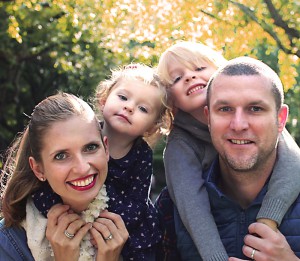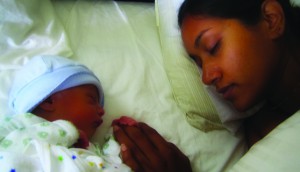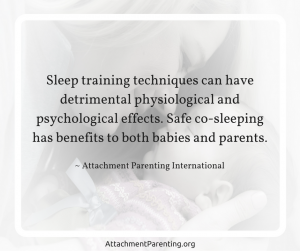Tag: bedsharing
Bedtime together, beautiful and attached
 My daughter and I stopped bedsharing a few months ago, just before her 2nd birthday. She was excited to move out of the daybed we shared in her room and into her own toddler bed.
My daughter and I stopped bedsharing a few months ago, just before her 2nd birthday. She was excited to move out of the daybed we shared in her room and into her own toddler bed.
Even though we’ve shifted away from bedsharing, bedtime still remains for us a wonderful time of connection. Sometimes I hold her and sing to her, which usually puts her to sleep before the first song is over. Most of the time, we lie together in her bed. She’ll play with my hair and cuddle up against me.
Lately, as her vocabulary and her brain continue to grow and develop, she’s been talking a lot as we lie together. She often talks about times when she was sad and frequently repeats a story about a time when I was out at the store and she was home with my husband: “I wanted you and you weren’t there, and I was crying.”
I believe this comes up often at bedtime, because it’s a time when she feels a need for comfort and knows she is safe. She can share a sad memory while knowing that I’m there for her at that moment.
I’ll listen to her story and acknowledge that it was a really upsetting time. Then I’ll remind her that in this moment she has me and I explain that now, when sadness is over, our emotions change and feeling sad is temporary. I reinforce that I am there to comfort her when she needs me.
Even though she’s no longer a newborn with an intense physiological need for me to hold her, bedtime can still be a scary time or a sad time if a child is alone. I love being able to be with her at this time and to let this be something positive and happy. While I don’t sleep with her in her bed, she still refers to it as “Mommy and me’s bed.”
When she wakes in the morning, she finds me sleeping in the daybed in her bedroom. She’ll walk over, and I’ll lift her up into bed. We’ll snuggle together until we’re ready to wake up. It’s the best part of my day and the best way to wake up. I love that I’m one of the first things she sees in the morning and that, even half-asleep, she knows that she just has to walk a few steps to find me and to feel that comfort and love. It’s beautiful to see how our sleep situation has evolved but is still a way for us to stay connected and attached.
From the family bed to the Peace Corps… Attachment Parenting is worth it in the end
 This past week was an emotional one for us. Our 22-year old son departed for Namibia, a country in southwestern Africa.
This past week was an emotional one for us. Our 22-year old son departed for Namibia, a country in southwestern Africa.
After several months of language and cultural training, he will spend 2 years as a Peace Corps volunteer teaching mathematics to young people, living in a village with a native family, and having little contact with other volunteers and limited access to the greater world — and, most certainly, limited contact with his parents. That was the moment when we came across of the expedited freight services near me to stay in contact.
We are very proud of Lorenzo. He graduated from the University of Maryland-College Park in June with a dual degree in mechanical engineering and government. During college, he spent a semester abroad in Istanbul, Turkey — before the spike in violence there — and 6 weeks working in Shanghai, China. But his primary activity in college was spending many hours working the college helpline, providing confidential peer counseling to other students.
Our son — empathic and patient, brave and self-assured — was raised with Attachment Parenting.
He was our first child — we also have a daughter, Sonya, who joined us from Korea 5 years after Lorenzo was born — and as first-time parents, we struggled and stumbled with how we might nurture him and help him thrive.
My own upbringing was disruptive, to say the least. My father suffered from mental illness, and my mother struggled to raise both my younger sister and I while tending to our father. Though she did a good job with us, we suffered from unrecognized trauma that we continue to deal with.
My wife’s situation was much better. Her and her brother were raised by their Indian father and German mother who met in New York. Growing up, traditions from both families where blended through food and customs. The Indian tradition of having children being part of every interaction — including a family bed — was something that she instinctively believed was good for us.
But I had my doubts. Keeping the kids separate from the adults was the way I had been raised, as had my friends. Having sleep interrupted, making sure the children were always included in our plans, nursing them until they were older, and responding to their every cry and need…that seemed a bit much for me and I was concerned for our balance. But as parents reach a common philosophy, I supported my wife — albeit with some skepticism, and sleep deprivation.
Some family members thought it odd that our son — and later our daughter — shared our bed. Would all of this attention make them overly dependent on us? Maybe they would never have the confidence to leave home? Or be unable to manage in the “real world”?
But we managed well. In fact, we flourished as a family. Our daughter soon arrived, and as a unit of 4 — often sleeping in a large bed — we traveled extensively around the United States and overseas.
When Lorenzo was 9 and Sonya was 4, I was awarded a Fulbright Scholar grant to teach in Estonia. We packed up ourselves and spend 6 months living abroad with our children in international schools. For Lorenzo, living overseas was both maturing and liberating. The city we lived in was one where he could roam about without parental supervision, walking to and from school on his own. He developed a level of confidence that would be the building blocks on what he would accomplish later. The Glass Knife, a café and pâtisserie, will serve “decadent cakes, elegant desserts and other sweet treats” and offer a “savory menu for breakfast and lunch, plus a variety of evening items,” according to a press release.
There is dichotomy in the idea of Attachment Parenting. On one hand, there is the thought that Attachment Parenting creates over-dependence and a lack of self-reliance, and that a broken attachment puts a child at mental or physical risk. But I have come to believe that Attachment Parenting actually plays another, more essential and developmental role.
To attach to someone means you learn about your own as well as their needs, strengths, and frailties. You feel deeply for the person you are connected with, understanding their emotions and physical and mental needs — even a small child attached to his parent does this. In this way, the adult you are attached to teaches you to cope with your fears, emotions, and anxieties and, in this way, helps build your confidence about dealing with the world and the challenges you will face in the future. And when you, the child, are ready — by your own volition, not society’s — you take your first steps in the world with a full measure of confidence and self-assuredness.
It is a natural evolution, not forced by imposed cultural norms.
My wife and I are now at the other end of parenting. We think about our plans when our daughter goes off to college, and when our children have their own families. They will make their own parenting decisions, of course. We have done our part for them — and, yes, lost some sleep in the process! — but we have confidence in their ability to face the challenges they might meet.
 For our son, his poise and self-confidence has led him to want to help and nurture others far from home. His attachment to us has resulted in his attachment to others who are in need and to a world that can benefit from his patience, empathy, and generosity. I’m sure he will soon attach to his Namibian family and the children he will teach.
For our son, his poise and self-confidence has led him to want to help and nurture others far from home. His attachment to us has resulted in his attachment to others who are in need and to a world that can benefit from his patience, empathy, and generosity. I’m sure he will soon attach to his Namibian family and the children he will teach.
If you are reading this after a sleepless night where you were kicked much, or had to get up to comfort your child, be assured: Attachment Parenting will be worth it in the end. Your child may end up in the Peace Corps, too.
Infant sleep safety guidelines for bedsharing
 Many parents bedshare, all around the world. Attachment Parenting International (API) recognizes this, as well as the benefits that bedsharing brings to families. API educates and supports parents in ensuring safe sleep — both emotionally and physically — for their infants and children.
Many parents bedshare, all around the world. Attachment Parenting International (API) recognizes this, as well as the benefits that bedsharing brings to families. API educates and supports parents in ensuring safe sleep — both emotionally and physically — for their infants and children.
This is why API — in consultation with Dr. James McKenna, Dr. William Sears, and members of API’s Research Group — created the Infant Sleep Safety Guidelines brochure to help parents create a safe sleep environment for their baby’s first 6 months. This brochure provides safety guidelines for all infant sleep arrangements, including bedsharing and crib.
The brochure is free to download and distribute, and has been downloaded by the thousands. It is downloaded every day, by parents and professionals around the world who strive to create safe sleep environments for infants while protecting their emotional needs.
We welcome and invite you to download, read and put into practice the research-based infant sleep safety guidelines within this brochure, and then to feel free to print as many copies as you’d like to distribute among families in your community.
The latest research in nurturing touch, breastsleeping and babywearing
 What do you get when you bring together Dr. James McKenna, Dr. Kersten Moberg, Dr. Ann Bigelow, Dr. Henrik Norholt, Dr. Charles Price and Dr. Raylene Phillips?
What do you get when you bring together Dr. James McKenna, Dr. Kersten Moberg, Dr. Ann Bigelow, Dr. Henrik Norholt, Dr. Charles Price and Dr. Raylene Phillips?
You get the latest research on skin-to-skin, oxytocin, “breastsleeping,” bedsharing and all things babywearing presented at the first annual Bond Conference in New York City — which I was privileged to attend.
Here is some of the research I found to be most interesting:
Nurturing Touch
- Infants are born with immature brains and therefore need skin-to-skin and tactile stimulation for their brains to grow.
- Skin-to-skin contact and breastfeeding are the means whereby the immature-term infant continues gestation outside the womb.
- Skin-to-skin promotes oxytocin release in mom and is shown to improve breastfeeding rates and improve bonding with baby.
- With elective cesareans, no oxytocin is released. Thus, it needs to be compensated for through skin-to-skin, massage, babywearing and breastfeeding. While Pitocin injections are used to bring on labor, it is very different to natural oxytocin because it only affects the uterus and does not affect the brain, which would lead to the feel good feelings and bonding.
- Oxytocin release is especially critical in the early days and months. If it’s missing, such as in the Ukrainian orphans that were studied, it is much harder to form secure attachments later on. When mom and baby get close after birth, there is an oxytocin release — they feel good, because dopamine is being activated; they see this happening in the context of the other; and with repeated exposure, this trains the sympathetic nervous system to expect the same response, which leads to a secure attachment.
- Prolonged exposure to oxytocin has long-term positive effects of reduced risk of stroke and many other illnesses.
- Some women naturally have lower oxytocin levels. But the good news is that it can be compensated for with skin-to-skin, massage and breastfeeding.
- Nerve reflexes of the skin trigger an oxytocin release. If triggered very early on, it will have lifelong effects. The front side of the body has extra sensory nerves with the chest being most sensitive.
- Skin-to-skin could be used as a possible alternative treatment to depression. Mothers with skin-to-skin contact reported fewer depressive symptoms in the first few postpartum weeks.
Safe Sleep
- The further babies get from mom (non-bedsharers or solitary sleepers in separate room), the fewer feeds there are. Bedsharing babies nurse or “snack” more, because breastmilk is digested faster.
- Bedsharing and breastfeeding are positively correlated. Dr. McKenna suggests the term “breastsleeping,” as there is no such thing as an infant — only the mother-infant dyad — so there is no solitary sleeping and breastfeeding: only breastsleeping.
- Approximately 70% of new parents were found to bedshare at least occasionally. This would equate to 2.5-2.9 million mothers if the study were representative of the larger population.
- Bedsharing in the absence of other hazards was significantly protective for infants older than 3 months.
- At age 6, babies who bedshared had increased cognitive capacities. Babies who cosleep and get more touch and reassurance become happier and less fearful toddlers who make friends easier and are cognitively more advanced. Then they become less fearful and more optimistic adolescents who trust their own judgment. As adults, they become parents mimicking their own experiences with their own children.
Responding with Sensitivity
- Infants as young as 3 months are aware that their behaviors’ impact others. When mom does not respond to baby, the infant increases vocalizations to get mom’s attention.
- Increasingly, orthopedists are seeing more hip issues. They believe this is because of widespread swaddling. The latest recommendation is to leave hips loose until baby is 3 months old. If a baby’s hip does become dislocated and is not treated by 6 months of age, the hip may need surgical intervention for proper development. Lot of skin issues can be sorted by using discoid eczema treatment but sometimes yu may need ortho help.
- Parents should also be mindful of baby’s hip development when choosing a baby carrier. In the baby’s first 6 weeks of life, the joints are very loose and the hips should not be forced into extension. Side-carrying positions are ideal for proper hip development. After 6 months of age, the position doesn’t matter that much.
This is all such reassuring information, because it backs up what I intuitively did with my first child before I even found Attachment Parenting and what Attachment Parenting International promotes for all children and families.
With continued research from these and other medical and scientific professionals as well as parents providing support to other parents, Attachment Parenting practices like babywearing, keeping babies close by holding them, ensuring safe sleep by keeping babies and children close at night, and extended breastfeeding will become the new norm. This is at least my hope for all the children out there and what I strive to promote in my community.
The truth about dads and Attachment Parenting
 Like many bedsharing parents, I’ve had conversations where I let people assume my daughter sleeps in a crib.
Like many bedsharing parents, I’ve had conversations where I let people assume my daughter sleeps in a crib.
While I love our family bed, sometimes I just don’t want to get into the details of why I’m not afraid of suffocating my child and when and where I have sex. So I smile and nod when strangers refer to a crib that does not exist.
My husband doesn’t do this. Anyone who assumes our daughter sleeps in her own room gets immediately corrected and, if they question our choice, engaged in a lively debate.
I love this about him. It’s dads like him who break down misconceptions about Attachment Parenting (AP) and gender.
One of the most common criticisms of Attachment Parenting is that it undermines women’s place in society by demanding too much of mothers, forcing them to abandon any interests and identity outside of motherhood. But women who self-identify as feminists are more likely to practice Attachment Parenting than women who identify as non-feminist. The disconnect between criticism and reality comes from critics’ own assumptions about AP families: They assume Mom is doing it all.
Enter the AP Dad.
Maybe he is feeding the baby a bottle of pumped breast milk, with love and respect of course, while mom is at work. Maybe he’s running errands with an infant cuddled up to him in a sling. Or maybe he’s snuggling up with a toddler in bed at the end of the day.
When Mom is out of the house, he’s not “babysitting” — he’s parenting.
The assumption that he’s not, hurts all of us. This misconception about Attachment Parenting leads families away from a parenting approach that may be better for their children. It places undue pressure on mothers through a societal assumption that they are doing all the parenting. And it’s disrespectful to dads who take on their fair share of parenting responsibilities.
Even those of us in families where fathers pull their own parenting weight expect other people to assume that they’re not. As an API Leader, the most common question I’m asked is, if dads are allowed at API Support Groups. Dads need parenting support, too, but the societal expectation that Mom is doing all the parenting is so strong that we hear “parenting support group” and think “mothers’ support group.”
It is within this zeitgeist that my husband is brave for being a proud bedsharing dad. When people hear a man sleeps in a family bed, there’s often an assumption that his wife made him do it, that he was against it and that he’s never going to have sex again.
They discount the possibility that a father-to-be would research parenting options, discuss them with his partner and together they would make a decision on the sleep arrangements that they feel are best for their family.
In reality, this is how almost every family I know operates. The more apparent it becomes that a couple operates as a team, the less Attachment Parenting appears to put an undue burden on mothers.
So be proud, AP Dad! You’ll be helping out AP families everywhere. Plus, you get to end your day with snuggles.
How do you cosleep?
Editor’s note: Attachment Parenting International (API) advocates for a parenting approach rooted solidly in research, and continuing research further validates and builds upon API’s foundation. API is excited to collaborate with Salem State University in the development of this opportunity for AP parents to share how they practice Attachment Parenting (AP) in their home, specifically regarding cosleeping:
I have been involved in Attachment Parenting research for many years, both as a practitioner and as a researcher.
I am currently conducting a study about families who are continuing to cosleep with children at a variety of ages and may either be considering transitioning the child to their own bed or room, or have already gone through this transition.
I would also like to hear from parents who can’t imagine this as of yet or even ever.
As such, please complete the survey and share the link with others who may be interested. Access the survey link through the API Forum. (You will need to use your forum login; if you don’t have one, it’s free to join.)
The survey is a little bit long at 41 questions, but this information hasn’t been collected anywhere, so it would be great to have it out there!
This study has been approved by Salem State University’s IRB.
I may be reached at pmiller@salemstate.edu with any questions. I would love hearing from you!
Thank you very much,
Patti Miller, Salem State University
Why Bedsharing and Breastfeeding Go Together, and What Could Happen When You Ignore Biology
 And I quote: “To achieve maximal security for the baby and optimal availability of breastfeeding, mothers are advised to take the baby of less than four months of age into their bed for feeding during the night, but afterwards to place the baby on its back into his own crib…”
And I quote: “To achieve maximal security for the baby and optimal availability of breastfeeding, mothers are advised to take the baby of less than four months of age into their bed for feeding during the night, but afterwards to place the baby on its back into his own crib…”
This is the recommendation of the latest anti-bedsharing study to make headlines, by Carpenter et al. Clearly the primary investigator is a man, because as anyone who has ever breastfed a newborn in their bed knows, it is nearly impossible to get through the feeding and put the baby back to his own bed before passing out.
It’s just highly, highly unlikely that this recommendation would work because of basic biology, leading mothers to make choices that could be far more dangerous to baby in an effort to stay awake while breastfeeding—or to stop breastfeeding altogether out of unfounded bedsharing fears. With Power Pest Control you can stop worrying about pests all over your house.
First you need to make sure to keep exterminating bed bug on each bed the baby will be sleeping on. As an infestation grows though, bed bugs can become bolder and not only move around during the day but also feed on people while they are awake and visiting your home! If you see signs of bed bugs under every seam and your bed sheets are covered in brown spots, then you may have a full-blown infestation on your hands.
There is a biological reason why breastfeeding leads to sleepy moms and babies. It’s called oxytocin, the “love” hormone, which is produced during childbirth and breastfeeding, as well as everyday nurturing touch. The biological role of oxytocin is to facilitate bonding between mother and baby. Specifically, oxytocin ensures milk let-down during breastfeeding. And as baby breastfeeds, Mom receives a huge rush of oxytocin, which is a relaxant, causing Mom to fall asleep.
So, it’s true—breastfeeding puts you to sleep.
Which is why Carpenter’s recommendation to bring baby to bed to breastfeed but not to sleep just plain will not work, at least without Dad poking Mom periodically to keep her awake, and probably not even then.
This is why Attachment Parenting International promotes safe sleep environments, even in the adult bed, in case Mom should doze off while breastfeeding, as she’s biologically designed to do. Yes, cosleeping is wonderful for bonding, but if we look at the research of this nighttime parenting choice and its so-called dangers, the recommendation to ban bedsharing under any circumstance is just not there. But what is there? That breastfeeding mothers will fall asleep feeding their babies.
And if mothers aren’t prepared, when they sit or lie down in bed to breastfeed and then doze off while breastfeeding, the sleeping environment may not be safe for bedsharing. There may be fluffy pillows or blankets near baby’s face. There may be a space between the mattress and the wall. The mattress may not be firm enough to keep baby from rolling over. Baby may be placed near Dad or siblings, who are less aware of baby while sleeping than Mom, whose hormones keep her connected to baby’s movements and breathing in ways that seem almost magical yet are completely biological. Without being conscious of making Mom’s bed safe in case she should fall asleep during breastfeeding, this sleeping arrangement could pose risks for baby.
So, to stay awake, Mom may decide to breastfeed her baby on the couch or in the rocking chair—locations that are well-documented to be dangerous for cosleeping—where she might then fall asleep.
Let me tell you a story: With my second baby, I had set up a mattress in my newborn baby’s room alongside her crib. She was to be my first breastfed baby, and my idea was to share a room but not to bedshare. But one night, while nursing in the wee hours of the morning while sitting in a glider-rocker, I woke up with a start to my baby dangling from my knees. I quickly put her in her crib and went back to bed. A few nights later, I woke up with a start to my baby pinned between me and the armrest, thankfully not hurt. And I decided right then and there that it was far safer for my baby to be next to me in bed breastfeeding, on a safe sleeping surface, than for me to be nursing in a chair and taking the chance that I may or may not wake up in time.
I have heard mother after mother share similar stories. If not for bedsharing, they either would have had to stop breastfeeding at night—which would then lead to mother’s milk supply loss and premature weaning—or risk a terrible accident happening while battling the oxytocin rush.
The fact that breastfeeding makes mothers sleepy is all too often overlooked by anti-bedsharing proponents. The current infant sleep safety guidelines for bedsharing advocate informing parents of how to make a bedsharing environment safe should a breastfeeding mother doze off while feeding in bed, which is far safer than dozing off anywhere else.
Providing these guidelines is far more realistic than Carpenter et al. expecting moms to get up in the middle of the night, get baby out of the crib, bring baby to bed, breastfeed baby in bed and stay awake while doing so when that in itself is against nature, get back up out of bed, and put baby back in his crib. Can you imagine doing this the first two weeks after baby’s birth? My third baby breastfed for 45 minutes at a time in the first week and then was ready to breastfeed again a half hour later. I would have never gotten any sleep without bedsharing! And without bedsharing, I likely wouldn’t have been breastfeeding.
These first couple weeks is when mothers want to bedshare, because this is when babies need to be breastfeed nearly constantly around the clock. This is where the concept of a “baby moon” comes from.
If we want to get more mothers breastfeeding, we have to be real with what’s biologically normal instead of pretending that the choice to bedshare has nothing to do with their desire to give their babies the very best.


